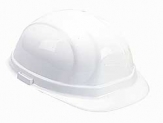 Workers are sometimes reluctant to use hard hats, even though their use is required in any type of construction area. But if you can do a good job of communicating to your employees why hard hat safety is essential, it’s often possible to reduce this resistance and get all of your employees on board with making hard hat use a habit in the workplace,
Workers are sometimes reluctant to use hard hats, even though their use is required in any type of construction area. But if you can do a good job of communicating to your employees why hard hat safety is essential, it’s often possible to reduce this resistance and get all of your employees on board with making hard hat use a habit in the workplace,
Hard hats usage in work zones is often required as a stipulation of insurance coverage, but if a workplace accident occurs and a hard hat were not being worn, employers may be fined for violating the 1983 Occupational Health and Safety Act, which states, “Employers have a ‘Duty of Care’ to ensure the health, safety and welfare at work of employees and others.”
Safety Education Is the Key
The best defense against this type of prosecution is a good offense. Namely, educating workers on the benefits of wearing hard hats.
Hard hats are often the minimum safety equipment required because of they protect the head, one of the most important parts of the body and the area most prone to injury in the workplace. The brain controls all of the body’s functions and the skull protects the brain from damage. Hard hats protect the skull and brain from falling or flying objects.
A falling object can generate a blow to the head that can be very damaging or even fatal. Force is calculated by the weight of the object and the distance of the fall. Even something as tiny as a washer can create a lot of force. For example, if it falls a distance of 30 feet, a washer will generate a force of 6.5 pound upon impact.
Shock Absorbers for the Head
Hard hats are designed to dissipate force. They have a hard shell which deflects direct blows to the head and an interior suspension system that acts as a shock absorber. When a falling object strikes a hard hat, the force created is transmitted and distributed to the neck and spine, reducing the force of the impact by about 75%.
Some specialized types of hard hats even act as an insulator against electrical shock.
In some cases, employees may complain about the weight of the hard hat, but a typical hard hat weighs less than one pound. Even a “system” hardhat equipped with a face shield and ear muffs weighs only slightly more than one pound. Compared with the average weight of a man’s head, which is 15 pounds, the proportional weight discomfort is relatively small.
Can Actually Dissipate Heat
Another common complaint is that hard hats generate too much heat. However, a recent test revealed that the interior temperature of hard hats can actually be lower than the ambient air temperature, particularly on hot, sunny days or in hot work areas. In addition, light colored hard hats have a reflective surface that can help dissipate the heat of the sun.
Bahrns carries a full selection of hard hats and other safety equipment you can use to minimize risk in your workplace.
